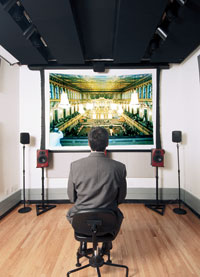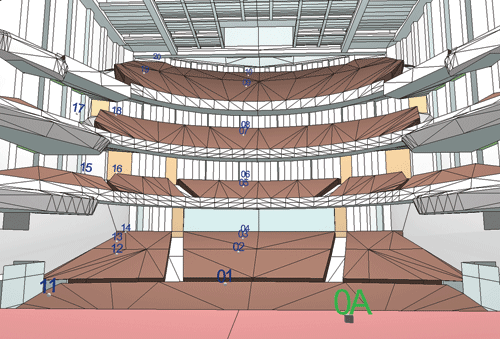Virtual but Vivid
For spaces that aren't yet built, engineers must create an impulse within a virtual acoustical model based on the architect's 2-D or 3-D digital files. Acousticians then estimate the response to the signal at locations throughout the room. Finally, they combine, or "convolve," this signature with music, speech, or other sound typically recorded in an anechoic, or reflection-free, environment. The computer adds the reflections and time delays to simulate the acoustical qualities specific to the proposed space.
 |
|
 |
Auralization and specialized listening environments, like the one in Arup's New York City office, allow for side-by-side comparisons of rooms that have sought-after acoustics with spaces that exist only as digital models. Here, an Arup acoustician compares Vienna's Musikvereinssaal (1870) with an unbuilt concert hall. Photos: Andreas Pessenlehner/EPA/Corbis (top); Arup (left) |
 |
|
With the audible output of this process, acousticians can then virtually adjust geometry or finishes and listen to how this will alter the sound. Or they can compare the sound of the still-unbuilt room to an existing one with sought-after acoustics. "We can easily move from space to space, and scenario to scenario," says Raj Patel, an acoustician and principal based in the New York City offices of Arup.
Acousticians can present auralizations via headphones. But a few acoustics practices, including Arup and Acentech, have purpose-built rooms in their offices where they can review these sonic renderings and present them to a group. The goal is to allow project decision makers to experience the sound of a proposed space collectively in an immersive setting. Such controlled environments typically include audio processing systems with multiple speakers working together to simulate the directional and three-dimensional qualities of sound.
The specialized rooms in acousticians' offices usually have a projection system for displaying architectural and acoustic visualizations. And in order to avoid coloring the listening experience, these spaces are designed to be acoustically neutral: They are relatively nonreverberant, with attention to isolation from mechanical noise and other disruptive sounds, but in general they are not anechoic. Even though an echo-free room would provide a more faithful rendition of the virtual space, it would be physically unpleasant, says Patel: "You would hear your own blood flow."









